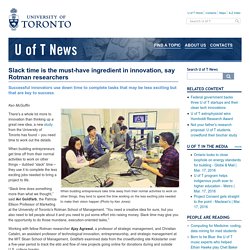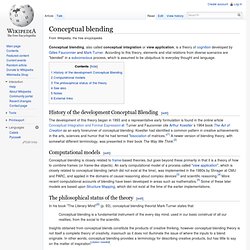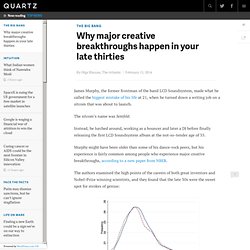

Dim Lighting Sparks Creativity. There are certain times when you want the lights turned way down low.

One such time, according to recent research, is when you need to think creatively. “Darkness increases freedom from constraints, which in turn promotes creativity,” report Anna Steidle of the University of Stuttgart and Lioba Werth of the University of Hohenheim. A dimly lit environment, they explain in the Journal of Environmental Psychology, “elicits a feeling of freedom, self-determination, and reduced inhibition,” all of which encourage innovative thinking. Steidle and Werth describe six experiments which provide evidence for their thesis. Slack time is the must-have ingredient in innovation, say Rotman researchers. Sub-title: Successful innovators use down time to complete tasks that may be less exciting but that are key to success Picture: When budding entrepreneurs take time away from their normal activities to work on other things, they tend to spend the time working on the less exciting jobs needed to make their vision happen (Photo by Ken Jones)

Don’t read the comments—they can make you mistrust real experts. In the wake of the recent measles outbreak in California and with the threat of more to come, it's clear that existing efforts to encourage vaccination and promote public health aren't enough.

We need to understand why the message isn’t sinking in where it’s most needed—why people believe what they believe and how they discover information they trust. A recent paper in the Journal of Advertising suggests that online commenting may sway people as much as public service announcements (PSAs) from health authorities. Depending on who's doing the commenting, comments may sometimes be even more influential than PSAs. While it may seem ludicrous that people could trust online comments as much as PSAs, it’s important to remember that online comments have an important advantage: they’re seen as coming from an unbiased source.
Feeling like you're an expert can make you closed-minded. What happens to us as we accrue knowledge and experience, as we become experts in a field?

Competence follows. Effortlessness follows (pdf). But certain downsides can follow too. LPT: when trying to come up with something creative, don't try to be creative. Write every idea down on a piece of paper and don't stop until you've got at least 100 ideas. : LifeProTips. Conceptual blending. History of the development Conceptual Blending[edit] The development of this theory began in 1993 and a representative early formulation is found in the online article Conceptual Integration and Formal Expression.

Turner and Fauconnier cite Arthur Koestler´s 1964 book The Act of Creation as an early forerunner of conceptual blending: Koestler had identified a common pattern in creative achievements in the arts, sciences and humor that he had termed "bisociation of matrices. "[1] A newer version of blending theory, with somewhat different terminology, was presented in their book The Way We Think.[2] Computational models[edit] The philosophical status of the theory[edit] In his book "The Literary Mind"[6] (p. 93), conceptual blending theorist Mark Turner states that.
Creativity & Taking it Easy. How To Be A Better Improviser. By Dan Goldstein.

First version 1996, last 2009. Try some of Dan's fun Psych experiments This document has been translated into German by Arne Poeck. A French translation was created by Hugo Labrande of ImproDisiaque. An older version of document has been translated into Slovene. These are some basic rules of thumb of improvisation. * = The key ideas. When you get a piece of information from another actor, first, accept it as fact and second, add a little bit more information to it. The swiftest way to add reality and depth to a scene is to have the characters call up specifics from their common history. --“Are you trying to get us arrested?” --“Like the time we ran naked through the Yale-Princeton lacrosse game?” Though just a few words, provides a great deal of information.
Some improv teachers suggest staying in the present tense as often as possible. Often in improvisation, things deviate from the normal, the usual. Example: Suppose, a character picks up the phone and calls Maureen. Major creativity happens in your 30's. James Murphy, the former frontman of the band LCD Soundsystem, made what he called the biggest mistake of his life at 21, when he turned down a writing job on a sitcom that was about to launch.

The sitcom’s name was Seinfeld. Instead, he lurched around, working as a bouncer and later a DJ before finally releasing the first LCD Soundsystem album at the not-so-tender age of 35. Murphy might have been older than some of his dance-rock peers, but his experience is fairly common among people who experience major creative breakthroughs, according to a new paper from NBER. The authors examined the high points of the careers of both great inventors and Nobel-Prize winning scientists, and they found that the late 30s were the sweet spot for strokes of genius: Innovators have been peaking slightly later in life as the 20th century has progressed, in part because today’s scientists have more to learn than their predecessors did: So why the late 30s?